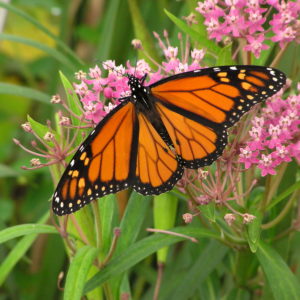The Monarch on Fall Migration
Last updated: October 5, 2021
Did you know that Monarch Butterflies travel up to 3000 kilometres south for the winter? Every year, these insects migrate an incredibly long distance to get to their wintering grounds in Central Mexico. Here, there are millions that congregate in a Canadian-type northern fir forest. The forest provides cover as the Monarchs drape themselves from the fir trees in the millions. They migrate to this particular habitat as it protects them from temperature extremes and dryness.
As they start their migration in late summer/early fall, you may be lucky to see more Monarchs buzzing around your NatureHood. One filmmaker in Toronto was lucky enough to see a number of Monarchs on their journey and captured a video to show our winged friends!
Aside from the fall migration – you will also see the Monarch coming back to Canada in early June. What better way to celebrate their return than to help this species! Over the last 20 years, the Monarch Butterfly population has seen a drop of over 80% due to habitat degradation, climate change, herbicides/insecticides, and invasive plant species. In Canada, the Monarch is listed as a special concern under the Species at Risk Act (SARA).
Monarch butterflies are important pollinators and their absence or presence can tell us a lot about changing environmental conditions. Like many other species, they depend on environmental cues to trigger reproduction, migration, and hibernation.
Planting Milkweed and other pollinator-friendly plants can help create more Monarch-friendly habitats in Canada. In fact, Milkweed is the only plant on which these butterflies can lay their eggs and subsequent caterpillars can feed on. Programs like Mission Monarch are also a great way to support population research through reporting and butterfly watches.
In 2015, Nature Canada worked with the Monarch Teacher Network of Canada to showcase the life cycle of the Monarch and display what teachers are doing to help protect this species.
Ever spotted these beautiful insects in your neighbourhood? Let us know through Facebook or Twitter!



